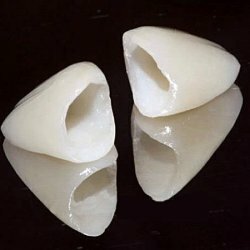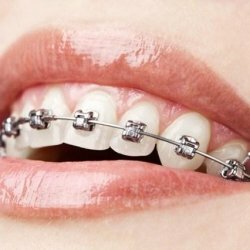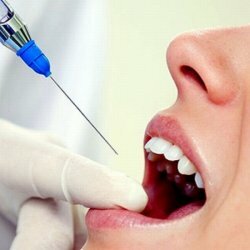Crowns used in dentistry
 Why is it useful to know information about the kinds of crowns, their features, pros and cons? This will help you answer many questions before you visit the dentist's office and reduce nervousness before admission. It is advisable to use crowns if the tooth is destroyed by more than 70%.
Why is it useful to know information about the kinds of crowns, their features, pros and cons? This will help you answer many questions before you visit the dentist's office and reduce nervousness before admission. It is advisable to use crowns if the tooth is destroyed by more than 70%.
What are Crowns Made of?
Crowns are made by dental technicians strictly according to the individual sample of a patient's teeth. Crowns are:
- metal( alloys of various metals),
- non-metallic( porcelain, plastic, ceramics),
- combined( a mixture of metal with ceramics, plastic or porcelain).Stamped crowns made of metal. Such crowns are made of stainless alloys, precious metals or plastics. Steel crowns are stamped from the sleeves and look like a cylindrical cap. For their production, steel grade 1X18N9T is taken.
Gold crowns are made from metal 900 samples, which is 90% of the total alloy. The gold of 750 samples is taken for the tooth ribs and the closing surface, which is due to the fact that the smaller gold content makes the crown more resistant to mechanical stress and deformation.
To date, stamping is gradually becoming a thing of the past.
Crowns made of cermets. The appearance of crowns, consisting of two layers: metal( cobalt-chrome or cobalt-nickel alloy) inside and ceramics from the outside. It is also possible to use precious metals instead of precious metals.
Metal-plastic crowns. Manufactured by casting and then covered with a layer of plastic.
Crowns made of non-metal ceramics. These structures are made entirely of ceramics: porcelain or zirconium oxide.
So, we have indicated the main types of crowns, which are often used and successfully manufactured by many dentists.
Why you need each kind of crowns
- Stamped crowns. They are done when the damage can not be eliminated by putting a seal, if the reliability of the tooth is in doubt, there are diseases of non-carious origin. These crowns are also placed with the rapid erosion of teeth. Can also be used as a support for the prosthesis.
- Crowns made of cermets. Are good for cosmetic purposes: correction of the form, position and shade of teeth. It is allowed to apply in caries, injuries, fluorosis, curvature of the teeth, increased erasure, allergies to other materials from which the crowns are made.
- Metal-plastic crowns. Most often set as temporary, their service life does not exceed 2-3 years.
- Metal-free ceramics. The scope of application is wide: from the treatment of destroyed teeth to the manufacture of prostheses on implants.
Pros of each type of
- Stamped crowns made from non-precious metals are attractive at a low price. The special strength of this kind allows them to be used for many years, they are not afraid of heavy loads. Teeth before the installation of the crown do not need serious grinding. This allows you to keep the pulp( nerve) and leave the tooth sensitive. While installing other crowns, the tooth is treated so much that it ceases to be alive. Many orthopedists recognize stamped crowns as the most durable and wear-resistant, despite the fact that they are very light and patients already adapt to them on the day of installation. Although these crowns are not devoid of flaws, which will be described below. Teeth that are out of sight are covered with crowns of non-precious metals, and teeth that open with a smile with gold and palladium alloys, because in this case the aesthetic side plays a role. Crowns made of gold, quite plastic, so they fit well to the tooth.
- Metal-ceramic crowns stand one step above the stamped ones. Cermets made of cermets are chosen, first of all, because of their high aesthetics. The outer side of the crown, made of porcelain, is as close as possible to the teeth standing next to it. Porcelain reflects light, so it differs little from the real enamel. Metal ceramic crowns are durable and will last 10-15 years, but they will not allow such tough handling as stamped. To ensure that the ceramic does not crack, it is necessary to avoid heavy loads on the teeth and chewing on hard food. An important advantage is the fact that the cermets can be placed in neglected cases. In recent years, this kind of crowns is becoming more popular due to the annual reduction in prices caused by competition among dentists. You can also vary the ratio of metal and ceramics, which will win in price.
- Metal-plastic crowns. The cheapest way to treat teeth is quickly produced and almost does not hurt the gums. The new crowns are almost indistinguishable from natural teeth.
- Metal-free ceramics. It is not inferior in terms of aesthetics to metal-ceramic crowns. Unlike the latter, it does not have a dark band on the border of the crown and gum. This kind of crowns is boldly attributed to hypoallergenic, since they do not have a skeleton made of a mixture of metals.
- . No matter how good the selected crowns seem to you, always pay attention to the shortcomings that they can have.
- Stamped crowns. Even those made of precious material look a little aesthetic and stand out from a number of native teeth. Most likely, you saw someone's "golden" teeth. Stamped crowns produce the same impression as they cause rejection in most patients. In addition, alloys from various metals often cause allergies, as well as effects of galvanic currents in the oral cavity.
- Metal-ceramic crowns are quite large and, as a rule, the nerve is completely removed before installing them. The technology of application is such that it is impossible to keep the living tissue of the tooth, it dies. About the strip of metal next to the gum, we already wrote above. But this is an insignificant drawback. While cracks in the ceramic lining, which appear after chewing hard and hard food, and the appearance of chips can lead to repeated treatment of the teeth. The presence of metal-ceramic crowns on the opposite side with native teeth provokes wear of the latter. Such an effect arises from the fact that ceramics are harder and stronger than natural enamel.
- Metal-plastic crowns. Over time, plastic under the influence of saliva exudes an unpleasant smell and darkens, resulting in the tooth appears gray. Substances produced by plastic can cause allergies.
- Metal-free ceramics. Crowns made without the addition of alloys are inferior in strength to the two types mentioned above. Any small load on the tooth can lead to the chip. Therefore, it is better to put them on the front teeth, where the pressure is not so great. In addition to their fragility, these crowns have a high price compared to metal and metal-ceramic crowns.
So, having familiarized yourself with the main types of crowns, knowing their advantages and disadvantages, you can more sensitively approach the issue of prosthetics and not make a mistake with the choice of crowns, because not every doctor will honestly tell you about possible pitfalls. As they say, who is forewarned is armed.



